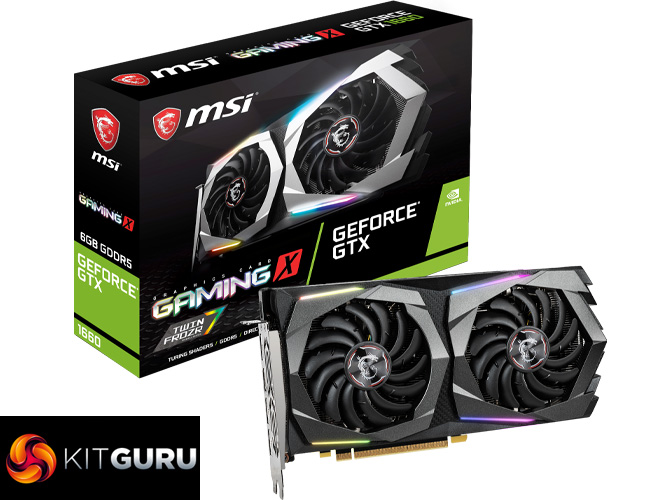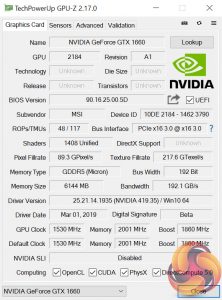
Almost three weeks ago, Nvidia launched the GTX 1660 Ti – the first GPU based on the Turing architecture to not have any RTX features. In what will come as a surprise to absolutely no one, today marks the release of the GTX 1660. GTX 1660 uses the same TU116 GPU as its bigger brother, but with one TPC disabled – meaning there are two less SMs and 128 less CUDA cores. It also keeps 6GB of VRAM, but in the form of older GDDR5 memory, rather than GDDR6. With prices starting at £199, is GTX 1660 worth buying?
While the baseline MSRP for GTX 1660 is indeed £199, the model we are looking at today is the MSI GTX 1660 Gaming X 6G. This has a much higher price tag of £249.99, making it very much a top-end GTX 1660 card. MSI is hoping the factory overclocked core, Twin Frozr 7 cooler and RGB lighting will be enough to tempt buyers to stump up the extra cash, but why don't we see for ourselves whether or not this price can be justified.
| GPU | GTX 1070 | RTX 2060 (FE) | GTX 1660 Ti | GTX 1660 | GTX 1060 |
| SMs | 15 | 30 | 24 | 22 | 10 |
| CUDA Cores | 1920 | 1920 | 1536 | 1408 | 1280 |
| Tensor Cores | N/A | 240 | N/A | N/A | N/A |
| Tensor FLOPS | N/A | 51.6 | N/A | N/A | N/A |
| RT Cores | N/A | 30 | N/A | N/A | N/A |
| Texture Units | 120 | 120 | 96 | 88 | 80 |
| ROPs | 64 | 48 | 48 | 48 | 48 |
| Rays Cast | 0.65 Giga Rays/sec | 5 Giga Rays/sec | – | – | 0.44 Giga Rays/sec |
| RTX Performance | 6.5 Trillion RTX-OPS | 37 Trillion RTX-OPS | – | – | N/A |
| GPU Boost Clock | 1683 MHz | 1680 MHz | 1770 MHz | 1785 MHz | 1708 MHz |
| Memory Data Rate | 8 Gbps | 14 Gbps | 12 Gbps | 8 Gbps | 8 Gbps |
| Total Video Memory | 8GB GDDR5 | 6GB GDDR6 | 6GB GDDR6 | 6GB GDDR5 | 6GB GDDR5 |
| Memory Interface | 256-bit | 192-bit | 192-bit | 192-bit | 192-bit |
| Memory Bandwidth | 256 GB/sec | 336.1 GB/sec | 288.1 GB/sec | 192.1 GB/sec | 192 GB/sec |
| TDP | 150W | 160W | 120W | 120W | 120W |
As we already mentioned, GTX 1660 uses the TU116 GPU – as seen in GTX 1660 Ti. It has been slightly scaled back for GTX 1660, however, with one less Texture Processing Cluster (TPC). Given that, within the Turing architecture, one TPC houses two Streaming Multiprocessors (SMs), GTX 1660 accordingly has 22 SMs instead of 24. Two less SMs also means 128 less CUDA cores, giving us a total of 1408.
The other notable change between GTX 1660 and 1660 Ti is the memory. Instead of using GDDR6 memory, the card reverts back to GDDR5 – and that is ‘just' GDDR5, not the faster GDDR5X which debuted with the GTX 1080. Nvidia says this is because G5 gives the ‘best balance of performance and cost' – so G5X/G6 is likely just too expensive for a £200 card. There is still 6GB of memory, but as it is G5 it runs at a slower 8 Gbps, with a total bandwidth of 192.1 GB/sec – effectively the same as GTX 1060.
Lastly, touching on boost clocks, a reference-spec card has a boost clock of 1785MHz. This Gaming X, as we mentioned, comes factory overclocked with a rated clock speed of 1860MHz. GPU Boost 4.0 will take this as far as it can without any manual overclocking, though, and we look at the real-world operating frequency of the card later in the review.
 KitGuru KitGuru.net – Tech News | Hardware News | Hardware Reviews | IOS | Mobile | Gaming | Graphics Cards
KitGuru KitGuru.net – Tech News | Hardware News | Hardware Reviews | IOS | Mobile | Gaming | Graphics Cards




